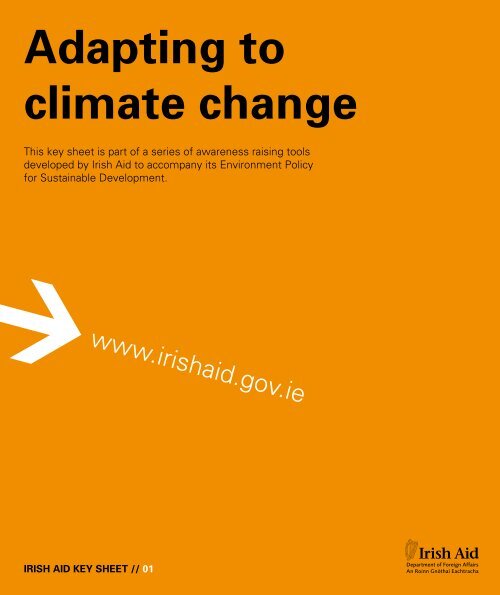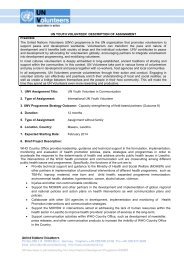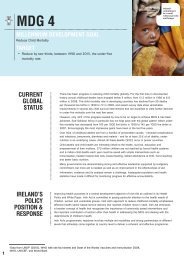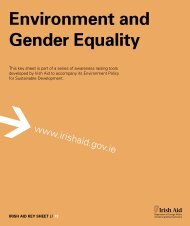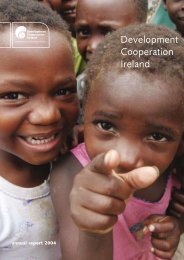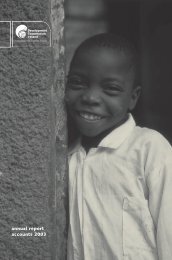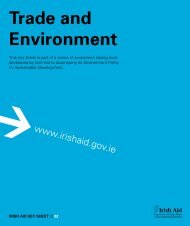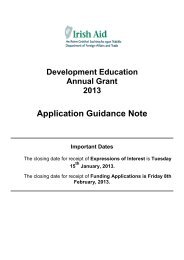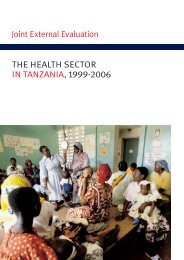Download PDF (407KB) - Irish Aid
Download PDF (407KB) - Irish Aid
Download PDF (407KB) - Irish Aid
Create successful ePaper yourself
Turn your PDF publications into a flip-book with our unique Google optimized e-Paper software.
Adapting to<br />
climate change<br />
This key sheet is part of a series of awareness raising tools<br />
developed by <strong>Irish</strong> <strong>Aid</strong> to accompany its Environment Policy<br />
for Sustainable Development.<br />
IRISH AID Key Sheet // 01
Key strategies for implementing <strong>Irish</strong> <strong>Aid</strong>’s Environment Policy for Sustainable<br />
Development are:<br />
i) mainstreaming, where the environment is recognised as a critical part of<br />
sustainable development and is taken into account in all policies, programmes,<br />
activities and funding decisions; and<br />
ii) partnership, where <strong>Irish</strong> <strong>Aid</strong> works with national governments, multilateral<br />
organisations, international agencies and civil society organisations to contribute<br />
to sustainable development.<br />
The first step in environment mainstreaming is to understand how the environment<br />
is linked to the development challenge or sector you are responsible for. In this key<br />
sheet, we explain why adapting to climate change is crucial, and suggest sources of<br />
additional information. More detailed guidelines on mainstreaming environment and<br />
adaptation to climate change will be produced at a later date.<br />
Adaptation to climate change matters to development because:<br />
> Climate change is a reality and people all over the world will have to adapt to<br />
some of its inevitable impacts.<br />
> Poor communities and least developed countries will be affected most by<br />
the impacts of climate change.<br />
> Climate change could reverse decades of investment in development and<br />
make it harder to meet the Millennium Development Goals.<br />
> Supporting “climate proof” and “low carbon” development pathways now<br />
will both help prevent climate change and help people adapt to its impacts.
Tree planting to stabilise dunes in Mauritania.
2. Why should we adapt to<br />
climate change<br />
2.1 What are the potential consequences of<br />
climate change<br />
The Intergovernmental Panel on Climate Change (IPCC), an<br />
expert panel of scientists, concludes that it is 90-99 per cent<br />
likely that the rise in global air temperature since the mid-<br />
1900s has been caused by human activity. Fossil fuel use, for<br />
instance, generates greenhouse gases that contribute to this<br />
warming trend.<br />
Average global temperatures are predicted to rise by about<br />
3°C by the end of the century, and although this might seem<br />
a small increase, its impact could be serious. Sea level could<br />
rise by as much as 59 centimetres over that period, and some<br />
projections indicate the complete disappearance of summer<br />
sea ice in the Arctic by the year 2100. Heat-waves and periods<br />
of heavy rainfall are likely to become more frequent. The IPCC<br />
states that in Africa agricultural production, including access<br />
to food is projected to be severly compromised by climate<br />
variability and change.<br />
Climate change is increasingly recognised as a developmental<br />
issue as well as an environmental one. Initially it was linked<br />
only to reducing greenhouse gases — primarily an energy and<br />
land use issue. Now, it is widely recognised that with some<br />
impacts unavoidable over the next decade or two, the first to<br />
suffer will be poor people in poor countries. So the need to<br />
adapt to climate change (see below), and in particular to help<br />
the poorest do so, is becoming a key issue, closely linked to<br />
poverty reduction and the Millennium Development Goals<br />
(MDGs).<br />
2.2 How can we adapt to climate change<br />
There are two types of responses to the threat of climate<br />
change. The first, mitigation, involves reducing emissions of<br />
greenhouse gases as a way of slowing or stopping climate<br />
change (see Climate Change and Poverty Reduction key sheet).<br />
The second, adaptation, is learning to cope with temperature<br />
increases, floods and the higher sea level associated with<br />
climate change.<br />
Adaptation is important for two reasons. First, some climate<br />
change impacts are inevitable. Even if emissions of all<br />
greenhouse gases were to stop immediately, due to lags in<br />
the earth’s natural processes, average temperatures would<br />
continue to rise for some time. Secondly, although scientists<br />
have made clear the urgency of reducing greenhouse gas<br />
emissions, politicians, businesses and individuals have been<br />
slow to translate this advice into action. Inadequate mitigation<br />
therefore means that adapting to the effects of climate change<br />
is crucial.<br />
3. How does adaptation<br />
relate to poverty<br />
3.1 The poorest countries are most affected<br />
Compared with industrialised countries, most developing<br />
nations have small greenhouse gas emissions, making<br />
mitigation a less urgent priority. Adaptation is very important<br />
in poor countries because they are more vulnerable to the<br />
impacts of climate change.<br />
Broadly speaking, there are two reasons for this vulnerability.<br />
One is low adaptive capacity — high levels of poverty, and a<br />
relative lack of the financial capability, institutional strength,<br />
skills, infrastructure, technology and other elements needed to<br />
cope with the effects of climatic shifts. The other is geographic<br />
location: large numbers of poor people live in areas such as<br />
drought-prone sub-Saharan Africa or flood-prone Bangladesh.<br />
Reliance on climate-sensitive sectors such as agriculture and<br />
fishing is also high in developing countries.<br />
The IPCC recognises Africa as a whole to be “one of the most<br />
vulnerable continents to climate variability and change because<br />
of multiple stresses and low adaptive capacity”. In Asia,<br />
“coastal areas, especially heavily-populated mega-delta regions<br />
in South, East and Southeast Asia, will be at greatest risk due<br />
to increased flooding from the sea and, in some mega-deltas,<br />
flooding from the rivers”. The IPCC also states that “small<br />
islands, whether located in the tropics or higher latitudes, have<br />
characteristics which make them especially vulnerable to the<br />
effects of climate change, sea level rise and extreme events”. <br />
Adaptive responses can be technological (such as sea defence<br />
construction), behavioural (such as altered food and recreational<br />
choices), managerial (such as altered farm practices) or policybased<br />
(such as planning regulations).<br />
IPCC (2007)<br />
IPCC (2007)
3.2 What techniques can poor countries use<br />
to adapt to climate change<br />
In agriculture-dependent communities, using drought-resistant<br />
crops, introducing new farming techniques and diversifying<br />
income sources can help. India and Mali are known for the<br />
strength of their agricultural professionals, and integrating<br />
climate change concerns into policy and planning is quite<br />
advanced. But in other countries, less progress has been<br />
made.<br />
Coastal zone management is an important sector in South<br />
Asia (India and Bangladesh in particular) as well as in Tanzania,<br />
the Gambia and Senegal in Africa. The Tanzanian coast, for<br />
instance, is vulnerable to problems such as pollution, erosion<br />
and the unsustainable exploitation of fisheries, so integrated<br />
coastal zone management (ICZM) is vital there. Planning for<br />
sea-level rise and vulnerability to storms and cyclones are<br />
both important. Coastal cities such as Alexandria in Egypt, and<br />
Banjul in The Gambia, will be particularly vulnerable.<br />
Climate-related disasters such as floods, cyclones and<br />
droughts are recurring problems for developing countries.<br />
In most countries, institutions and plans to deal with early<br />
warning, relief, rehabilitation and recovery exist. Some are<br />
quite successful (such as the cyclone early warning system in<br />
Bangladesh), but many are inefficient and unlikely to be able<br />
to cope with future disasters exacerbated by climate change. <br />
Strengthening national and local capacity in disaster risk<br />
reduction and disaster management by working with existing<br />
structures such as the Comprehensive Disaster Mitigation<br />
Programme in Bangladesh is essential. In Mozambique, the<br />
natural disaster programme is also looking at incorporating<br />
climate change adaptation in its disaster risk reduction strategy.<br />
Health professionals must start planning for climate change<br />
impacts. Increases in Malaria have been predicted for several<br />
countries, and incidences of waterborne diseases are expected<br />
to become more frequent. <br />
Box 1 Community-based adaptation in Cavite City 4<br />
Cavite City, a conurbation on the coast of the Philippines, is highly vulnerable to tropical cyclones, drought and sea-level<br />
rise. Current climate-related problems include coastal erosion, siltation and sedimentation, storm surges and urban flooding,<br />
saltwater intrusion into water resources and degradation of water quality. Poor people, especially fishers and shellfish growers,<br />
are affected most. Some have already acted on adaptation by:<br />
> Accommodating sea-level rise by building houses on stilts<br />
> Strengthening the physical structure of houses<br />
> Moving to safer places during disasters<br />
> Placing sandbags along the shorelines<br />
> Borrowing money from relatives or acquiring usurious loans from moneylenders<br />
> Engaging in alternative income-generating activities locally or in other areas<br />
> Changing occupation.<br />
Such strategies, however, are inadequate and not effectively integrated into existing local development plans. The government<br />
has also instigated adaptation activities, including relief assistance, resettlement and shoreline protection. These have reduced<br />
the vulnerability of coastal households, but these measures too are inadequate and they are also costly.<br />
Adaptation strategies proposed by local people are mostly non-structural measures such as policy and institutional reforms<br />
regarding coastal zone management, property rights, micro-finance/insurance schemes disaster risk management, fisheries/<br />
aquatic resource management and community-based adaptation.<br />
Communities feel that local capacity development is important, as is improving knowledge management.<br />
Red Cross and Red Crescent Climate Centre, the Netherlands (2004)<br />
Faustino, R. (2007)
4. Climate change and international goals<br />
Climate change will make meeting the Millennium Development Goals (MDGs) even more difficult (see Box 2).<br />
Box 2 How climate change will impede meeting the Millennium Development Goals 4<br />
Eradicate extreme poverty and hunger (MDG 1)<br />
Poor people are generally the most vulnerable to climate change. They are also more dependent on ecosystem services and<br />
products for their livelihoods. Any effect that climate change has on natural systems therefore threatens the livelihoods, food<br />
intake and health of poor people.<br />
Climate-induced changes to crop yields will dramatically affect many poor people’s livelihoods. Climate change-induced changes<br />
in infrastructure and labour productivity are also expected to alter the path and rate of economic growth. This will increase<br />
poverty by reducing income opportunities. Poor people are particularly vulnerable to extreme weather events.<br />
Achieve universal primary education (MDG 2)<br />
Natural disasters and drought may require children to help more with household tasks, leaving less time for schooling.<br />
Malnourishment and disease also impair learning and can be related to climate change. Weather-related disasters threaten<br />
school buildings in many poor countries. Education becomes a low priority following the loss of a home or the need to migrate<br />
following a flood, storm or drought.<br />
Promote gender equality and empower women (MDG 3)<br />
Climate change is expected to exacerbate current gender inequalities. Women are usually responsible for fetching water,<br />
fodder, firewood and sometimes food in poor households. They therefore bear disproportionate hardship when provision of<br />
these vital necessities becomes difficult. In times of extreme stress, men often migrate, leaving women and girls behind to<br />
cope with heavier domestic and work burdens.<br />
Health related issues (MDGs 4, 5 and 6)<br />
Direct effects of climate change include higher levels of mortality and illness associated with heat waves, particularly among<br />
the elderly and the urban poor. Extreme weather events will also cause more death and injury. Women and children are<br />
particularly vulnerable to extreme weather events.<br />
The indirect effects of climate change on health are more significant. Climate change may increase the prevalence and<br />
distribution of vector-borne diseases such as malaria and dengue fever. Vulnerability to water, food, or infectious diseases<br />
such as cholera and dysentery is also likely to increase. Children and pregnant women are particularly susceptible to vector<br />
and waterborne diseases. Climate change will reduce the quantity and quality of drinking water, which is a prerequisite for<br />
good health. Malnutrition, an important cause of ill health among children, could also be exacerbated due to declining natural<br />
resource productivity and food insecurity.<br />
Ensure environmental sustainability (Goal 7)<br />
Global warming is likely to shift ecosystem boundaries. This may mean that some protected areas no longer protect the species<br />
they were designed to conserve. Extinction rates may increase, and for many species, climate change poses a greater survival<br />
threat than the destruction of their natural habitat. Shifts in reproductive cycles and growing seasons could also occur. Coral<br />
reefs have already shown devastating losses as a result of increased water temperatures. Degradation of biodiversity will<br />
reduce the availability of many traditional medicines. This will affect poor and rural people who depend on natural resources for<br />
medicine as well as income and food. Water supplies are expected to drastically decrease in many arid and semi-arid regions.<br />
Slum dwellers will be particularly vulnerable to climate change.<br />
Global partnerships (Goal 8)<br />
The benefits of investment in development could soon be entirely absorbed by dealing with the costs of weather related<br />
disasters. Many poor countries depend on tourism, but climate change could destroy the beaches, reefs and coastal<br />
infrastructure on which this depends. Climate change will also severely affect the agricultural sector. All these factors will affect<br />
gross domestic product, national debt, the state of public finances, and investment in development in poor countries.<br />
5 Reid, H. and M. Alam (2005)
But strategies to tackle climate change could learn from<br />
approaches used to meet the MDGs and other international<br />
agreements. For example, the ecosystem approach advocated<br />
in the Convention on Biological Diversity (CBD) could provide<br />
a useful tool for integrating biodiversity, livelihood and climate<br />
change concerns (see Box 3). <br />
Box 3 The ecosystem approach<br />
The ecosystem approach is a strategy for the integrated<br />
management of land, water and living resources that<br />
promotes conservation and sustainable use in an equitable<br />
way. It is based on the application of appropriate scientific<br />
methodologies focused on levels of biological organization<br />
which encompass the essential processes, functions and<br />
interactions among organisms and their environment. It<br />
recognizes that humans, with their cultural diversity, are<br />
an integral component of ecosystems. The ecosystem<br />
approach is the primary framework for action under the<br />
Convention on Biological Diversity.<br />
Another potentially useful approach is the Hyogo Framework<br />
for Action. A blueprint for disaster risk reduction, the<br />
Framework aims to reduce the loss of lives and of the social,<br />
economic and environmental assets of communities and<br />
countries by 2015 by providing guiding principles, priorities and<br />
practical means for action. Climate change adaptation will also<br />
be part of environmental mainstreaming into development<br />
plans and poverty reduction strategies.<br />
5. Mainstreaming adaptation<br />
in development<br />
Adaptation to climate change needs to be mainstreamed into<br />
development policy and practice at national, international<br />
and regional levels. Particular attention needs to be paid<br />
to supporting community-based approaches to adaptation.<br />
Building on the considerable body of knowledge already<br />
possessed by poor people is essential. In the Yamuna River<br />
area of Rajasthan, India, for instance, a number of poor<br />
communities have revived traditional rainwater harvesting<br />
methods in the form of johads — small semicircular dams<br />
— and helped recharge groundwater and virtually drought-proof<br />
their villages. <br />
Climate change forecasts at the local level are poor but they<br />
are, in any case, not a prerequisite to building local adaptive<br />
capacity: communities that are already vulnerable to climate<br />
variability, such as those near coasts or in arid areas, are likely<br />
to be vulnerable to future climate change. That said, there is a<br />
need for more and better quality climate information in Africa,<br />
to facilitate better planning.<br />
5.1 Action within countries<br />
> Many developing countries have a good core of<br />
professional planners and managers operating in<br />
key sectors. But they are usually unaware of the<br />
potential impacts of climate change on their sector.<br />
Climate risk assessment — studies to determine how<br />
robust infrastructure, services and other elements<br />
of development will be in the face of climate change<br />
— needs to be incorporated into development activities by<br />
all these professionals. For example, professionals involved<br />
in planning and managing for irrigation, flood management<br />
and drinking water provision need to factor climate change<br />
risk management into their regular practices for designing<br />
water structures and measures.<br />
> Vulnerability to climate change can be reduced or<br />
increased by the choice of development path. For example,<br />
national investment in large-scale agricultural programmes<br />
may be misplaced if more droughts and flash floods are<br />
expected. Small-scale drought resistant agriculture might<br />
be more sustainable in the long term.<br />
> Each country needs its own plans and institutions<br />
to ensure adaptation is both mainstreamed into<br />
development activities (such as integrated water resources<br />
management) and considered at a strategic planning level<br />
(for example, planning for increased malaria incidence<br />
in the health sector). The LDCs are currently preparing<br />
National Adaptation Plans of Action (NAPAs), which<br />
alongside other national strategies and plans should help<br />
link knowledge on climate change impacts and adaptation<br />
into national policy and planning processes.<br />
> Incorporating climate change risks into national<br />
development activities at both project and strategic levels<br />
requires greater institutional capacity in most developing<br />
countries. Hence <strong>Irish</strong> <strong>Aid</strong> is supporting capacity<br />
development for decision makers in developing countries<br />
through the UN Institute for Training and Research’s<br />
Climate Change Capacity Development programme (C3D).<br />
6 UN International Strategy for Disaster Reduction<br />
7 UN International Strategy for Disaster Reduction<br />
8 European Union<br />
9 Tarun Bharat Sangh
A young sorghum seed struggles to grow in parched earth, Affole, Mauritania. Successive droughts and the<br />
attractions of settled life have reduced the number of nomadic herders in the country to about 250,000.
5.2 Bilateral processes<br />
> Investment projects from bilateral or multilateral<br />
institutions and the private sector need scrutinising and<br />
modifying to ensure they are both “climate proof” and<br />
“climate friendly” (see Box 4). <br />
> Donor agencies have an important role to play in<br />
supporting local processes that enable poor people to<br />
better cope with climate change impacts. Participatory<br />
processes and a holistic approach incorporating all aspects<br />
of sustainable development are needed. 1011<br />
> There is also a need for capacity development in donor<br />
agencies and with partners.<br />
Box 4 “Climate-screening”<br />
investment portfolios<br />
The risks of not addressing climate change need to be<br />
factored into donors’ investments. The recent Stern<br />
Review 10 on the economics of climate change clearly<br />
demonstrates the cost-effectiveness of reducing<br />
greenhouse gas emissions early on as a means of<br />
preventing globally catastrophic impacts in the long term. In<br />
the shorter term, investing in adaptation to reduce, but not<br />
eliminate, upcoming impacts and associated costs is also<br />
important.<br />
The reality, however, is that climate change has traditionally<br />
received scant attention from international donor<br />
organizations and governments. International organisations<br />
such as the International Monetary Fund and World Trade<br />
Organization give little consideration to climate change<br />
in their projects. For example, a WB, OECD , IADB<br />
study suggests that 20%-40% of all ODA is subject to<br />
climate risk. Clearly, international donor agencies need to<br />
assess the extent to which their investment portfolios in<br />
developing countries might be at risk due to climate change<br />
and take steps to reduce that risk.<br />
Several bilateral and multilateral development agencies and<br />
NGOs recognise this and are starting to take an interest. 11<br />
At least six development agencies have screened their<br />
project portfolios, both to ascertain the extent to which<br />
existing development projects consider climate risks or<br />
address vulnerability to climate variability and change, and<br />
to identify opportunities for incorporating climate change<br />
explicitly into future projects.<br />
10 Stern (2006)<br />
11 Klein, R. J. T. et al. (2007)<br />
12 Raworth, K. (2007)<br />
5.3 International action<br />
> Developed countries that signed up to the UNFCCC are<br />
required to help more vulnerable countries with costs of<br />
adaptation; (see Box 5).<br />
> Vulnerability to climate change is explicitly linked to<br />
poverty. Developed countries therefore need to fulfil all<br />
the agreements made in the past, such as the agreement<br />
the international community made in Monterrey to spend<br />
0.7 per cent of gross national product on development<br />
cooperation, the Paris Agenda, where countries pledged<br />
to make improvements and increase harmonisation and<br />
integration with the policies of partner countries, and other<br />
agreements on good governance, women’s rights and<br />
children’s rights to help foster growth and fight poverty.<br />
Action on curbing loss of income from trade barriers, debt<br />
relief, provision of untied aid, investment and a commitment<br />
from wealthy nations to curb consumption is also needed.<br />
Box 5 Funds for adaptation<br />
Several financial mechanisms exist under the UNFCCC<br />
and the Kyoto Protocol to support adaptation activities,<br />
particularly in developing countries. The following four<br />
funds contain a total of US$310.22 million so far, although<br />
the costs of adaptation for developing countries alone are<br />
likely to be several billion dollars each year: 12<br />
1. The Least Developed Countries Fund supports the<br />
development of National Adaptation Plans of Action<br />
(NAPAs), and will probably assist the LDCs to implement<br />
their NAPA projects. The fund comes from voluntary<br />
contributions from wealthy countries (such as Ireland<br />
through <strong>Irish</strong> <strong>Aid</strong> and the Department of the Environment,<br />
Heritage and Local Government).<br />
2. The Special Climate Change Fund is for all developing<br />
countries and covers adaptation and other activities; it is<br />
also based on voluntary contributions.<br />
3. The Adaptation Fund is meant to support “concrete<br />
adaptation” activities. It is based on private sector<br />
replenishment though the 2 per cent levy on Clean<br />
Development Mechanism projects (which channel carboncutting<br />
energy investments financed by rich-country<br />
companies to developing countries), plus voluntary<br />
contributions.<br />
4. The Strategic Priority on Adaptation fund contains US$50<br />
million from the Global Environment Facility’s trust funds to<br />
support pilot adaptation activities.<br />
In addition to these funds, several bilateral funding<br />
agencies, including those from Canada, Germany, the<br />
Netherlands, Japan, the United Kingdom and the United<br />
States, have allocated funding for adaptation activities<br />
that include research and pilot projects. Bilateral donors<br />
have provided around $110 million for over 50 adaptation<br />
projects in 29 countries.
Fulani villagers carry water back to the village past some<br />
goats in the early morning, Dembel Jumpora, Guinea Bissau.
References and Resources<br />
Printed on Era Silk recycled paper,<br />
made from 50% genuine recovered paper waste<br />
and 50% virgin fibre from well-managed forests.<br />
ADB, DFID, EC, DGIS, BMZ, OECD, UNDP, UNEP, World Bank. Poverty and Climate Change: Reducing the Vulnerability of the<br />
Poor through Adaptation: A Report by ten international development funding agencies providing links between climate change and<br />
development actions and policies. See www.oecd.org/dataoecd/60/27/2502872.pdf<br />
Alam, M. and L. Murray (2005) Facing up to climate change in South Asia. Gatekeeper 118. IIED, London. See<br />
www.iied.org/NR/agbioliv/gatekeepers/index.html<br />
Convention on Biological Diversity. See information on the Ecosystem Approach at www.cbd.int/programmes/cross-cutting/<br />
ecosystem/default.shtml<br />
DFID Key Sheets on Climate Change and Poverty. See www.dfid.gov.uk/pubs/files/climatechange/keysheetsindex.asp<br />
European Union. See the EU action plan on climate change in the context of development cooperation at http://europa.eu.int/<br />
comm/development/body/theme/environment/index.htm.<br />
Faustino, R. (2007) Mainstreaming Adaptation Towards Integrated Coastal Management: The vase of Cavite City, Philippines.<br />
Presentation by Ramon Faustino Jr. Assistant Director, Conrado Benitez Institute for Sustainability, Philippines at the Community<br />
Based Adaptation Workshop, Dhaka, 24-27 February.<br />
Huq, S., H. Reid and L. Murray (2006) Climate change and development links. Gatekeeper 123. IIED, London. See www.iied.org/<br />
NR/agbioliv/gatekeepers/index.html<br />
IPCC (2007) Climate Change 2007: Impacts, Adaptation and Vulnerability: Summary for policymakers. Working Group II<br />
Contribution to the Intergovernmental Panel on Climate Change Fourth Assessment Report.<br />
Klein, R. J. T. et al. (2007) Portfolio screening to support the mainstreaming of adaptation to climate change into development<br />
assistance. Climatic Change (forthcoming).<br />
Orindi, V. A., and L. Murray (2005) Adapting to climate change in East Africa: A strategic approach. Gatekeeper 117. IIED, London.<br />
See www.iied.org/NR/agbioliv/gatekeepers/index.html<br />
Raworth, K. (2007) Adapting to Climate Change: What’s needed in poor countries, and who should pay Oxfam Briefing Paper 104.<br />
Oxfam International.<br />
Red Cross and Red Crescent Climate Centre, the Netherlands (2004) Preparedness for Climate Change: A study to assess the<br />
future impact of climatic changes upon the frequency and severity of disasters and the implications for humanitarian response and<br />
preparedness. See www.climatecentre.org/downloads/File/reports/preparedness_climate_change.pdf<br />
Reid, H. and M. Alam (2005) Millennium development goals. Tiempo: A Bulletin on Climate and Development 54: 18-22.<br />
Stern, Nicholas (2006) Stern Review on the Economics of Climate Change. HM Treasury, London. See www.sternreview.org.uk.<br />
Tarun Bharat Sangh. See information on its work with the Yamuna River villages to revive their own traditions of water harvesting at<br />
www.tarunbharatsangh.org.<br />
UNFCCC. NAPAs submitted to the UNFCCC to date are available at http://unfccc.int/national_reports/napa/items/2719.php<br />
UN International Strategy for Disaster Reduction. See a downloadable version of the Hyogo Framework at<br />
www.unisdr.org/eng/hfa/hfa.htm.<br />
Useful websites<br />
> Intergovernmental Panel on Climate Change (IPCC) www.ipcc.ch<br />
> Tiempo www.tiempocyberclimate.org/portal/bulletin.htm<br />
> The UN Framework Convention on Climate Change and the Kyoto Protocol http://unfccc.int<br />
> UN International Strategy for Disaster Reduction www.unisdr.org<br />
All photography: Panos


